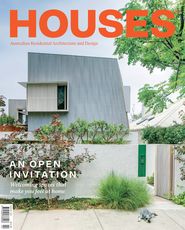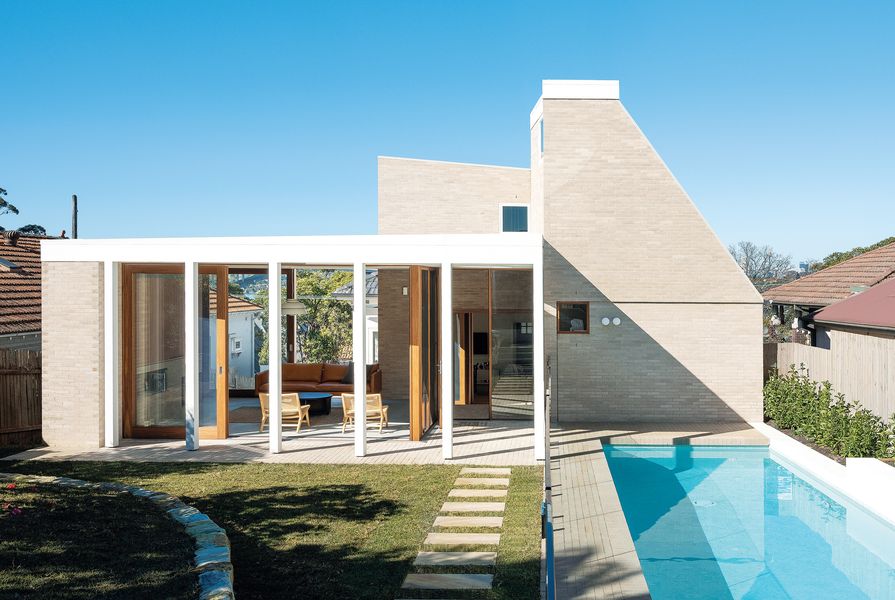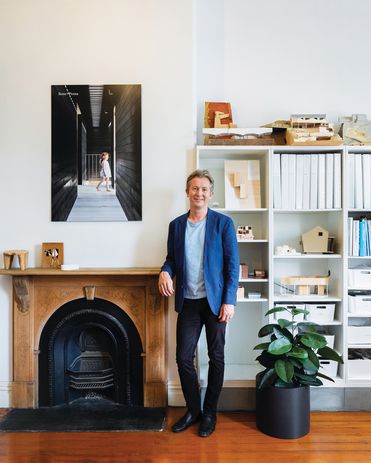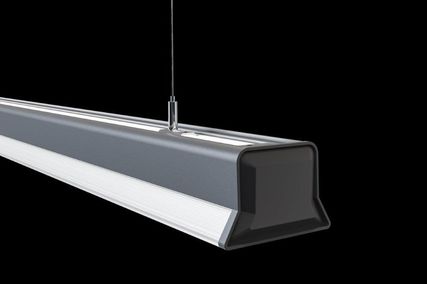In small alterations and additions projects, it takes an exceptional level of skill to make calm and considered spaces. Benn and Penna’s work, of a modest scale thus far, is well known for consistently minimizing unnecessary trickiness and maximizing craft. Usually, each project is characterized by one or two materials, used thoroughly and creatively to create a memorable sense of “home.”
Andrew Benn, director of Benn and Penna Architects.
Image: Katherine Lu
Director Andrew Benn’s preoccupation with a restrained use of materials has developed over 20 years. After graduating from UNSW Sydney in 2001 with first-class honours, he worked for UN Studio in Amsterdam, which set a suitably high bar in terms of ambition. Andrew was heavily involved in the documentation of UN Studio’s Villa NM, a rich but restrained project in upstate New York (which unfortunately burnt down only months after completion). The early 2000s in the Netherlands were influential years, as OMA founder Rem Koolhaas and MVRDV inspired a generation of architects with their tectonic restraint and inventiveness. When Andrew returned to Australia, he worked for Engelen Moore (continuing with Ian Moore Architects after that firm split), before moving to BVN. Benn and Penna was then launched in 2012. When describing his practice, Andrew explains that he hopes to always have a small practice “to express my creativity.”
The original shell of Balmain Pair (2013) was carefully retained and judiciously, but boldly, added to.
Image: Tom Ferguson
An early project, Balmain Pair (2013) had a decade-long gestation period. Andrew’s mother had bought a pair of semi-detached houses in the Sydney suburb of Balmain while Andrew was working overseas, and every Christmas, the extended family would sit around and tease out ideas for the project. The semi-detached pair of single-storey houses had a layout of two rooms plus a lean-to. The original shell was carefully retained and judiciously, yet boldly, added to. The corner dwelling now has a bedroom to the street and a large study tucked into the rear of the roof upstairs, looking north-east to the harbour. The sibling dwelling has a clever layout, including a separate studio to the street and another – larger – apartment, accessed down a side path. In this apartment, which overlooks a private rear garden, an elegant stair rises through a void and past a large study to the rear bedroom. All of the original materials have been cleaned and, where reconfigured, reused, and the new insertions are almost all finely clad with timber that complements the colour of the raw brick. Slatted screens cover windows, and form balustrades and louvred panels, affording an elegant consistency to the diverse accommodation.
Parallel to this project, Benn and Penna was working on a tiny guest house in New South Wales’s Southern Highlands, the studio’s first independent commission. The brief was for a small additional building to a well-known project by Beverley Garlick Architect, built in 1993 while Andrew was a student in her office. The original two pavilions have barrel-vaulted roof forms constructed of corrugated iron, as does Benn and Penna’s small addition. The small lozenge-shaped new structure is separate from the other two forms but linked to them by a covered walkway. It is, in fact, two concentric lozenges in plan – one a roof form that covers the whole footprint, the other a smaller half-lozenge form that contains a curved, book-lined room with glass doors to the covered verandah. Like its neighbours, this gem is also clad in corrugated iron, but laid horizontally rather than vertically. The site is relatively isolated and the play of architectural forms against the background of rolling hills is exceptionally evocative. It was a perfect first project.
In Balmain Rock (2018), a concrete lintel above the doorway signals a material transition between old and new.
Image: Tom Ferguson
Balmain Rock (2018) was the next significant project tackled by the practice and is now justifiably well known. The project encompassed a complex restoration of a tiny, two-room stone cottage (now one large room with walls of exposed sandstone) and the design of a new off-form concrete addition behind it. The build was as complicated as realizing two completely separate projects on the same tiny site. The steeply pitched roof form of the historic (but, remarkably, not heritage-listed) cottage has been retained, while the new ceiling follows the inside of the pitch, with a large skylight to the rear. In the addition, crazy-paving flooring continues from the bridge connecting the old with the new across a courtyard and into the open dining room and kitchen. A stair, top-lit by a void, rises to two bedrooms and a bathroom. The main bedroom looks out over a rear garden that is higher than the ground floor. The mixture of sandstone, paving, impeccable concrete and brick makes for a rich tactile experience.
Balmain Rock fuelled Andrew’s growing preocc-upation with the intensity of materials, and a subsequent project in the Sydney suburb of Naremburn furthered this ideation. In Naremburn Twin Peaks (2018), a new, two-storey rear extension adopts the form of the original bungalow’s pitched roof with a pair of steeper twin peaks. The new addition, all black-stained cedar externally, houses three bedrooms on either side of a narrow, top-lit corridor also clad internally in blackened timber. Inside each of the generous bedrooms the palette is all white, a pointed contrast to the hallway space. Here, Benn and Penna was inspired by Kengo Kuma’s work, and the result is reminiscent of its muse.
Two stained cedar pavilions hover above the open ground level at Naremburn Twin Peaks (2018).
Image: Tom Ferguson
Henley Clays (2019) continued to stretch the architectural possibilities of an alterations and additions commission. This project – on a slightly less hemmed-in site, with more garden than building – marked the first time that Benn and Penna had a sense of space in the garden and landscape to work with. From the garden, higher than the house and with an in-ground pool tucked into one side, one can clearly identify the three interlocking pavilion forms clustered around a central space that is part-courtyard, part-house. The new part of the house is separate from the existing house and towers above it, with a “stair chimney” that draws cool air up through the stair void to a secluded main-bedroom eyrie.
The two tonnes of cementitious baked brick used throughout the house make up the walls, stairs and floors. The living-room pavilion faces the eastern courtyard and the western garden, and is marked by a smooth concrete floor. The western garden elevation is shielded from the sun by a loggia, supported by fine white columns. The project shows finesse in its very restrained use of rich materials.
Benn and Penna’s work to date has showed a masterful manipulation of incredibly constrained conditions to produce exceptional outcomes. The resulting dwellings convey a comfortable and honest occupancy. The team will complete a larger, more elaborate new Palm Beach house in the coming months. Given their skill working in very constrained situations, their work will no doubt continue to develop as the confines of tight sites and budgets are released.
Source

People
Published online: 29 Sep 2020
Words:
Genevieve Lilley
Images:
Katherine Lu,
Tom Ferguson
Issue
Houses, April 2020






























